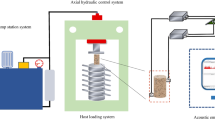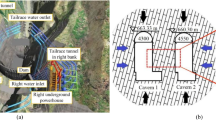Abstract
During the excavation of underground opening, the rock may experience a complex loading path that includes the highly confined compression before excavation, unloading of confining stress and further disturbance of dynamic loading after excavation. By using Rock Failure Process Analysis for Dynamics (RFPA-Dynamics), the failure of rock sequentially subjected to this complex loading path is numerically simulated, in order to examine the rock failure mechanism induced by excavation. The RFPA-Dynamics is firstly used to reproduce the failure of rock under confined compression, followed by unloading of confining pressure, and it is validated against with the existing experimental observation. Then, the failure characteristics of rock specimen sequentially subjected to the quasi-static triaxial loading, unloading of confining pressure and dynamic disturbance are numerically simulated, where the effect of magnitude of axial loading and confining pressure, and duration and amplitude of the dynamic disturbance on the final failure patterns of rock are examined. The numerical results indicate that the arc-shaped spalling damage zone is prone to develop with the increase in the axial pressure and lateral pressure coefficient. As for the effect of dynamic disturbance, the contribution of duration and amplitude of dynamic disturbance on the energy input are similar, where the area of damage zone increases with the energy input into the rock specimen. In this regard, the area of the damage zone is influenced by both the magnitude of in situ stress and waveform of dynamic disturbance. This study denotes that it is of great significance to trace the complex loading path induced by excavation in order to capture the rock failure mechanism induced by underground excavation.














Similar content being viewed by others
References
Backblom G, Martin CD (1999) Recent experiments in hard rocks to study the excavation response: implications for the performance of a nuclear waste geological repository. Tunn Undergr Space Technol 14:377–394
Bossart P, Meier PM, Moeri A, Trick T, Mayor JC (2002) Geological and hydraulic characterisation of the excavation disturbed zone in the Opalinus Clay of the Mont Terri Rock Laboratory. Eng Geol 66:19–38
Cai M, Kaiser PK (2005) Assessment of excavation damaged zone using a micromechanics model. Tunn Undergr Space Technol 20:301–310
Corkum AG, Martin CD (2007a) The mechanical behaviour of weak mudstone (Opalinus Clay) at low stresses. Int J Rock Mech Min Sci 44:196–209
Corkum AG, Martin CD (2007b) Modelling a mine-by test at the Mont Terri rock laboratory, Switzerland. Int J Rock Mech Min Sci 44(6):846–859
Diederichsa MS, Kaiser PK, Eberhardt E (2004) Damage initiation and propagation in hard rock during tunnelling and the influence of near-face stress rotation. Int J Rock Mech Min Sci 41(5):785–812
Fakhimi A, Carvalho F, Ishida T, Labuz JF (2002) Simulation of failure around a circular opening in rock. Int J Rock Mech Min Sci 39:507–515
Falls SD, Young RP (1998) Acoustic emission and ultrasonic-velocity methods used to characterize the excavation disturbance associated with deep tunnels in hard rock. Tectonophysics 289:1–15
Forquin P, Gary G, Gatuingt F (2008) A testing technique for concrete under confinement at high rates of strain. Int J Impact Eng 35:425–446
Frew DJ, Akers SA, Chen W, Green ML (2010) Development of a dynamic triaxial Kolsky bar. Meas Sci Technol 21(10):105704. doi:10.1088/0957-0233/21/10/105704
Guan Z, Jiang Y, Tanabasi Y (2007) Ground reaction analyses in conventional tunnelling excavation. Tunn Undergr Space Technol 22:230–237
He MC, Zhao F (2013) Laboratory study of unloading rate effects on rockburst. Disaster Adv 6:11–18
He MC, Miao JL, Feng JL (2010) Rock burst process of limestone and its acoustic emission characteristics under true-triaxial unloading conditions. Int J Rock Mech Min Sci 47(2):286–298
Hing LK, Othman SZ, Hashim R, Ismail Z (2014) Determination of soil stiffness parameters at a deep excavation construction site in Kenny Hill Formation. Measurement 47:645–650
Hua AZ, You MQ (2001) Rock failure due to energy release during unloading and application to underground rock burst control. Tunn Undergr Space Technol 16(3):241–246
Huang D, Li YR (2014) Conversion of strain energy in triaxial unloading tests on marble. Int J Rock Mech Min Sci 66:160–168
Huang RQ, Wang XN, Chan LS (2001) Triaxial unloading test of rocks and its implication for rock burst. Bull Eng Geol Environ 60:37–41
Huang ZP, Tang CA, Ma TH, Tang LX (2011) Numerical test investigation on unloading rockburst processes. Chin J Rock Mech Eng 30(1):3120–3128
Kim Y, Amadei B, Pan E (1999) Modeling the effect of water, excavation sequence and rock reinforcement with discontinuous deformation analysis. Int J Rock Mech Min Sci 36:949–970
Kostić S, Vasović N, Perc M, Toljić M, Nikolić D (2013) Stochastic nature of earthquake ground motion. Physica A 392:4134–4145
Labiouse V, Vietor T (2014) Laboratory and in situ simulation tests of the excavation damaged zone around galleries in opalinus clay. Rock Mech Rock Eng 47:57–70
Lapčević R, Kostić S, Pantović R, Vasović N (2014) Prediction of blast-induced ground motions in a copper mine. Int J Rock Mech Min Sci 69:19–25
Li XB, Zhou ZL, Lok TS, Hong L, Yin TB (2008) Innovative testing technique of rock subjected to coupled static and dynamic loads. Int J Rock Mech Min Sci 45(5):739–748
Li XB, Cao WZ, Zhou ZL, Zou Y (2014a) Influence of stress path on excavation unloading response. Tunn Undergr Space Technol 42:237–246
Li XJ, Yang WM, Wang LG, Butler IB (2014b) Displacement forecasting method in brittle crack surrounding rock under excavation unloading incorporating opening deformation. Rock Mech Rock Eng 47:2211–2223
Malmgren L, Saiang D, Toyra J, Bodare A (2007) The excavation disturbed zone (EDZ) at Kiirunavaara mine, Sweden—by seismic measurements. J Appl Geophys 61(1):1–15
Martino JB, Chandler NA (2004) Excavation-induced damage studies at the underground research laboratory. Int J Rock Mech Min Sci 41:1413–1426
Read RS (2004) 20 years of excavation response studies at AECL’s underground research laboratory. Int J Rock Mech Min Sci 41:1251–1275
Sazzad MM (2014) Micro-scale behavior of granular materials during cyclic loading. Particuology 16:132–141
Sellers EJ, Klerck P (2000) Modelling of the effect of discontinuities on the extent of the fracture zone surrounding deep tunnels. Tunn Undergr Space Technol 15:463–469
Tao M, Li XB, Wu CQ (2012) Characteristics of the unloading process of rocks under high initial stress. Comput Geotech 45:83–92
Tao M, Li X, Li D (2013) Rock failure induced by dynamic unloading under 3D stress state. Theoretical and Applied Fracture Mechanics 65:47–54
Varas F, Alonso E, Alejano LR, Fdez-Manín G (2005) Study of bifurcation in the problem of unloading a circular excavation in a strain-softening material. Tunn Undergr Space Technol 20:311–322
Vrakas A, Anagnostou G (2014) A finite strain closed-form solution for the elastoplastic ground response curve in tunneling. Int J Numer Anal Methods Geomech 38:1131–1148
Weibull W (1951) A statistical distribution function of wide applicability. J Appl Mech 18:293–297
Wu FQ, Liu T, Liu JY, Tang XL (2009) Excavation unloading destruction phenomena in rock dam foundations. Bull Eng Geol Environ 68(2):257–262
Xie HQ, He C (2004) Study of the unloading characteristics of a rock mass using the triaxial test and damage mechanics. Int J Rock Mech Min Sci 41:13–18
Yang HQ, Zeng YY, Lan YF, Zhou XP (2014) Analysis of the excavation damaged zone around a tunnel accounting for geostress and unloading. Int J Rock Mech Min Sci 69:59–66
Ye ZY, Zhao FJ, Zhou ZL (2013) Mechanical characteristics of unloading rock under coupled dynamic and static loads. Chin J Geotech Eng 35(3):454–459
Yin ZQ, Li XB, Jin JF, He XQ, Du K (2012a) Failure characteristics of high stress rock induced by impact disturbance under confining pressure unloading. Trans Nonferrous Met Soc China 22:175–184
Yin ZQ, Li XB, Yin TB, Jin JF, Du K (2012b) Critical failure characteristics of high stress rock induced by impact disturbance under confining pressure unloading. Chin J Rock Mech Eng 31(7):1355–1362
Zhao JD, Wang G (2010) Unloading and reverse yielding of a finite cavity in a bounded cohesive-frictional medium. Comput Geotech 37(1–2):239–245
Zhou XP, Shou YD (2013) Excavation-induced zonal disintegration of the surrounding rock around a deep circular tunnel considering unloading effect. Int J Rock Mech Min Sci 64:246–257
Zhou XP, Zhang YX, Ha QL (2008) Real-time computerized tomography (CT) experiments on limestone damage evolution during unloading. Theor Appl Fract Mech 50(1):49–56
Zhou ZL, Li XB, Zou Y, Jiang YH, Li GN (2014) Dynamic Brazilian tests of granite under coupled static and dynamic loads. Rock Mech Rock Eng 47:495–505
Zhu WC, Tang CA (2004) Micromechanical model for simulating the fracture process of rock. Rock Mech Rock Eng 37(1):25–56
Zhu WC, Tang CA (2006) Numerical simulation of Brazilian disk rock failure under static and dynamic loading. Int J Rock Mech Min Sci 43(2):236–252
Zhu WC, Li ZH, Zhu L, Tang CA (2010) Numerical simulation on rockburst of underground opening triggered by dynamic disturbance. Tunn Undergr Space Technol 25(5):587–599
Zhu WC, Bai Y, Li XB, Niu LL (2012) Numerical simulation on rock failure under combined static and dynamic loading during SHPB tests. Int J Impact Eng 49:142–157
Zhu WC, Wei J, Zhao J, Niu LL (2014a) 2D numerical simulation on excavation damaged zone induced by dynamic stress redistribution. Tunn Undergr Space Technol 43:315–326
Zhu WS, Yang WM, Li XJ, Xiang L, Yu DJ (2014b) Study on splitting failure in rock masses by simulation test, site monitoring and energy model. Tunn Undergr Space Technol 41:152–164
Acknowledgements
This work is funded by the National Key Research and Development Program of China (Grant No. 2016YFC0801607), National Science Foundation of China (Grant Nos. 51525402, 51374049, 51474051 and 51534003), the Key Project of Chinese Ministry of Education (No. 113019A) and the Fundamental Research Funds for the Central Universities of China (Grant Nos. N160104008, N160103005). These supports are gratefully acknowledged.
Author information
Authors and Affiliations
Corresponding author
Rights and permissions
About this article
Cite this article
Niu, L., Zhu, W., Cheng, Z. et al. Numerical simulation on excavation-induced damage of rock under quasi-static unloading and dynamic disturbance. Environ Earth Sci 76, 614 (2017). https://doi.org/10.1007/s12665-017-6955-4
Received:
Accepted:
Published:
DOI: https://doi.org/10.1007/s12665-017-6955-4




